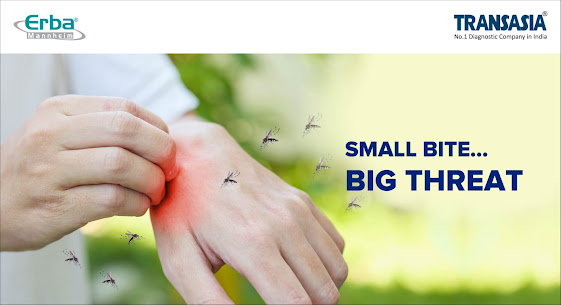Small Bite Big Threat!
Remember Louie, the
mosquito who was born out of the need to endorse a brand of repellent? Well,
Louie may be wiped off our memories sooner or later, but the menace caused by
mosquitoes is far from over!
Malaria, dengue and chikungunya are a cause of
major concern worldwide. Amongst them dengue, is listed among the top ten
global health threats. A highly debilitating and fatal mosquito-borne
arboviral disease, it is
caused by the dengue virus (DENV) which has four serotypes, making it possible
to get infected four times.
According to the WHO, the incidence of dengue has grown
exponentially around the world in recent decades with about half of the world’s
population now at risk. However, 80% cases are generally mild and asymptomatic.
70% of the burden lies in Asia.
Prevalence in India
Dengue fever has become a huge
concern in the last decade in India. It has been reported that 34% of the global cases of dengue are from
India only*. In 2021, more than 1.9 lakh cases were recorded, according
to the Ministry of Health and Family Welfare. However, national data suggests that there was a decline
in the total number of cases in 2021 compared to 2019. Though, experts
believe that COVID-19 may have hampered the reporting of many cases.
States like Delhi, Haryana, Punjab, Uttar
Pradesh, Rajasthan, Madhya Pradesh, and Maharashtra are the most affected.
The good news is that Case Fatality Rate (deaths per 100
cases) has been sustained at less than 1% since 2008.
Strategies adopted by the government to curb
the spread
The government has set up the National Centre for Vector-Borne Disease Control
Programme (NVBDP) to prevent and control the spread of vector-borne diseases
such as malaria, dengue, chikungunya and kala-azar. Some of the initiatives of
NVBDP include:
·
Development
and implementation of several long-term action plans and guidelines for
clinical management of dengue fever, dengue hemorrhagic fever and dengue shock
syndrome.
·
Establishing
the 713 Sentinel surveillance hospitals with laboratory support for augmentation of diagnostic facility for
dengue in endemic state(s). These are linked with 17 apex referral laboratories
with advanced diagnostic facilities for back-up support. These hospitals offer
free diagnostic facilities.
·
To maintain
the uniformity and standard of diagnostics in these laboratories, IgM MAC ELISA
test kits along with NS1 antigen and IgG GAC ELISA kits are used.
Further, multidisciplinary central teams have been deployed
in endemic states to ensure availability of sufficient diagnostic kits,
medicines, insecticides, fogging machines and funds. In addition to the IgM
kits, the central government has also provided states with funds for
procurement of NS1 kits for early diagnosis.
Detection of dengue
infection
While there is no specific treatment for dengue/severe dengue, early detection
can lower fatality rates of severe dengue to below 1%. The Government of
India’s National Vector Borne Disease Control Program, recommends the
application of different diagnostic method, depending on when the patient
presents with symptoms:
· ELISA-based
NS1 antigen tests: Dengue NS1 antigen, is abundant in the serum of patients
during the early stages infection. It is a simple test that is highly specific
and sensitive.
· IgM-capture
(MAC-ELISA): MAC-ELISA is based on detecting the dengue-specific IgM
antibodies that develop faster than IgG antibodies and are usually detectable
by day 5 of symptoms. This test is especially useful for hospitalized patients,
who are generally admitted later during the infection after detectable IgM is
already present in the blood.
· IgG-ELISA
(GAC-ELISA): An IgG-ELISA compares well to the haemagglutination-inhibition
(HI) test. It can also be used to differentiate primary and secondary dengue
infections. The test is simple and easy to perform but it is not considered in
combination with IgM assays as it indicates past infections only.
· Rapid
Diagnostic Tests (RDTs): Easy accessibility and affordability make these
tests a preferred choice especially in resource-constrained settings. Several
independent studies have indicated the correlation between the results obtained
by RDTs and ELISAs.
Choose the right test to eliminate the chances of misdiagnosis and
missed diagnosis
Transasia Bio-Medicals offers Made in India tests for both ELISA and rapids for
detection of dengue. Tests based on indirect ELISA method for antibodies are
often marred with cross-reactions with other Flaviviruses, pathogens and immune
disorders such as rheumatoid arthritis. Moreover, many cases are also
misdiagnosed as other febrile illnesses.
Transasia’s ErbaLisa Dengue ELISA offers a complete portfolio of
highly sensitive and specific kits for detection of Dengue NS1 Ag based on
Sandwich ELISA, Dengue IgM based on u-capture (MAC) and Dengue IgG based on
immunocapture (GAC) methods.
The ErbaQik Dengue
DUO rapid tests are devised on immunochromatography technique (ICT) for
detection of dengue NS1 Ag with differential detection of IgG/IgM antibodies
for all four serotypes of dengue virus.
The only company in
India to offer a DUAL COLOUR ADVANTAGE
Transasia’s ErbaQik Dengue DUO rapid test deploys different sized gold particles
as conjugate in the test membrane strip. As the sample passes through the
strip, the gold particle conjugate creates a coloured test and control band. As
a general rule, the colour of the gold particle solution changes with the
change in the size of the particle, ranging from red to purple black with the
increasing particle size. This gives the kit a UNIQUE DUAL COLOUR ADVANTAGE
making it the only bi-colour detection immunochromatographic device in India.
Moreover, the larger size of the gold particle provides a larger surface area
for the reaction, thereby enhancing the sensitivity and the specificity of the
test and reducing the incidence of false results.
Authored by:
Ajinkya Upasani
Asst. Product Manager – Immunology
Transasia Bio-Medicals Ltd.

.jpeg)



Comments
Post a Comment